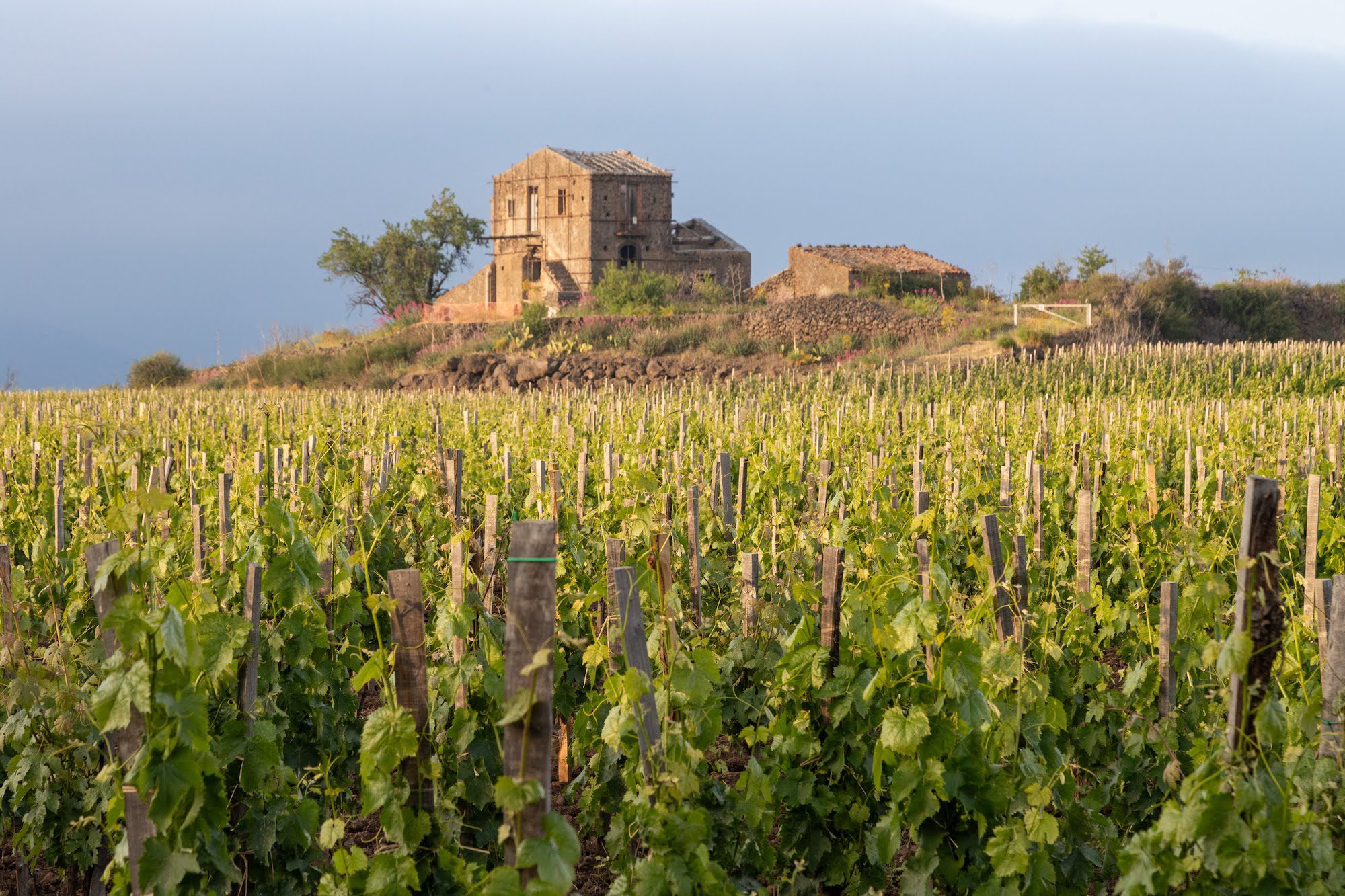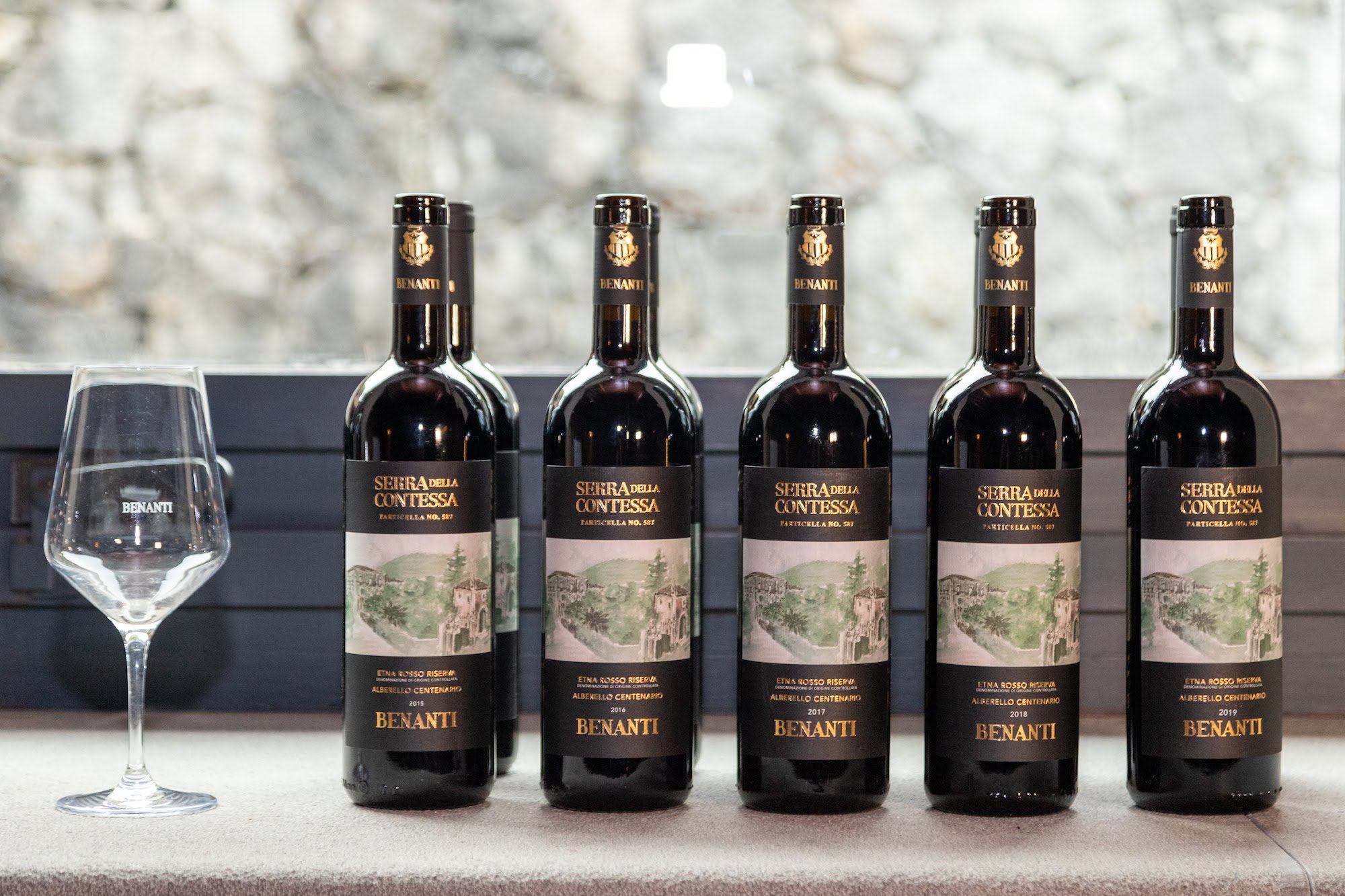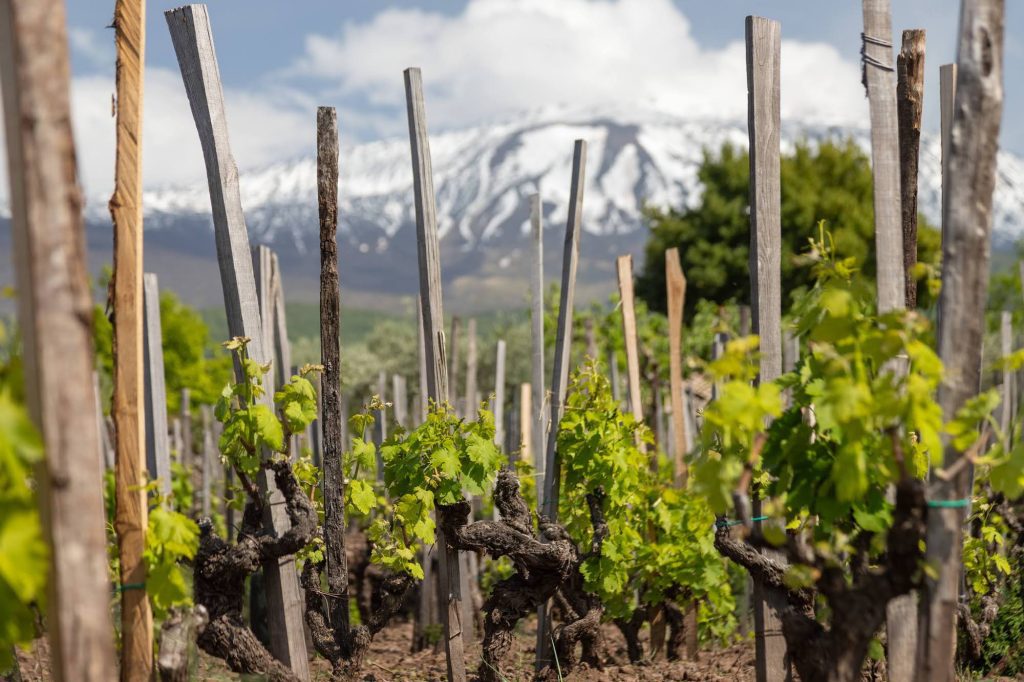Amanda Barnes engages with the fascinating terroir of Sicily’s striking and active volcano, as her palate is swept away by some stunning bianco and rosso wines, made by a dedicated bunch of winemakers, some who even bottle ‘illegal’ varieties.
Etna is an explosive terroir. A volcanic wine region on the island of Sicily, almost touching the African continent, it is steeped in history and mystery. Greek mythology attributed the fiery nature of Etna to a snake-like monster, Typhos — the deadliest creature in Greek mythology — who lived in the volcano’s crater.
A few hundred years after the Ancient Greeks, this smoking volcano became a wine region and, in fact, it used to be one of the most productive wine regions of Italy. Barely a century ago, there were 100,000 hectares of vines on Etna. Today, however, that number is much closer to 1,000 hectares. It is no surprise really that the vineyard plantings dwindled — planted on steep terraces with small, old bush vines, the work is backbreaking. (I think even Typhos would have given up.)
But it is exactly because of this challenging environment that the grapes of these vines can make some of Italy’s most distinctive and exciting wines. The low-yielding vines, often producing less than a kilo of grapes per vine (less than third of what a younger vine does), produce concentrated, characterful and sometimes fierce wines, with a piercing acidity that can guarantee their life expectancy in the bottle for decades. Just in the nick of time it would seem, Etna has experienced a comeback. A growing handful of brave producers are investing their time, money and backs into championing and protecting these old vines and traditional viticulture of the region.
Although Etna only accounts for 2% of Sicilian wine, the wines of Etna certainly punch above their weight in terms of reputation. This reputation in recent years has largely been built on the quality of the wines taken from the old vines, with increasing focus being drawn onto the distinctive expressions of the different crus, or contrade, of the volcano.
An island on an island: the different world of Etna
Etna volcano scrapes the sky at 3,357 m.a.s.l., not only one of the highest volcanoes in Europe but indeed one of its highest mountains. The vines of Etna are planted between 450 and 1,300 m.a.s.l., making them the some of the highest in Europe.
This altitude changes the wines dramatically from the vineyards on the flats below. While they bake in the warmth of the southern Mediterranean sun, not far from the coast of Tunisia, Etna is a different world. It is a world of cold nights and significantly more rain, with a climate entirely unto its own. Although Etna might be on an island, these are mountain wines.
The bubbling volcano and activity underground also gave rise to the volcanic soils. Repeated lava flows over history has created a complex matrix and layers of different volcanic soils, which lend their own character to the wines — and allow vine roots to run deep in search of water sources. Hence the impressive survival of many of these vines for well over 150 years.
Surviving as a vineyard in Etna though doesn’t come without its perils. Etna is one of the world’s most active volcanos, in a constant state of activity. When Etna does erupt, any lava flow would put an end to vines in its path, and there are some fascinating vineyards you can visit which remain testimony to just that experience — with half of the vineyard decimated by lava, while the remaining, untouched, vines continue to thrive.
However it isn’t only lava flows that can cause damage. The regular eruptions of Etna volcano can shoot out tiny rocks that make their way from the sky into the vineyards — winemakers have given these little lava rocks the rather charming name, ‘sky soil’. The small rocks (usually the size of an ant) can cause some leaf or grape damage but are, fortunately, too large to settle on the vines or interfere with winemaking chemistry. Instead, they drop to the floor with gravity or are blown to the ground by wind.

A race to save the old vines
The revival of the wines of Etna is a relatively recent phenomenon. Until the 1990s, the vineyards of Etna were in steep decline. Several families made it their mission to revive its fortunes, by focusing on premium wines and then trying to convince the world of their worthiness. The Benanti family was one of those pioneers. Although the historic estate dates back to 1734, it was Giuseppe Benanti who bucked the trend of wineries during the early 1990s when it was common to ship the wines in bulk to other regions in Italy.
“In the 80s and 90s, no-one wanted to hear about Etna,” Salvino Benanti, son of Giuseppe, explains. “There were a few pioneers, including my father, who believed Etna’s wines could be fine wines.” His father was a businessman and an avid believer that Etna’s wines could be among the best in the world, and dedicated much time and capital to not only developing his own fine wines but also to taking them to different places around the globe to share with critics and buyers.
After decades of hard graft, the groundwork has come to fruition. Through the testimonies and wines of those modern pioneers, several new investors have come to the region — including Moretti family from Tuscany, who founded Animaetnea. Winemaker Emiliano Falsini feels that the rise of Etna is not dissimilar to that of Bolgheri. “When I started my career in Bolgheri in 2000, there were only eight producers at the time… today there are more than 100. Etna has seen a similar trajectory.”
Following the success of the modern pioneers in showing the quality potential for Etna wines, the next stage is showing the differences between the contrada crus and exploring this diversity through the region’s wines. “The beauty of Etna is that every contrada is different,” adds Emiliano. “In Santo Spirito, for example, we have a very shallow topsoil and more rocky soils, so the Nerello Mascalese tastes different — a more vertical wine.”
The Benanti family’s portfolio, which encompasses 35 hectares in five locations, covering all the major slopes of Etna, certainly offers the best opportunity to taste several different contrada and compare the styles. In general terms, the cooler north produces earthier, more floral reds, while the wetter and windier east is known for the top, ageworthy white wines, and the southern slopes are warmer and suitable for both offering more breadth and ripeness.
An opportunity to taste a vertical of Benanti’s Serra Della Contessa and Rovittello parcel wines, from their old vines in the south and north respectively, showed the clear character differences. Both are vinified in a similar way, with no interference of new oak, lending even more transparency to the contrada differences. Covering vintages from 2019 to 2015, although it was a clear a certain vineyard performed better in a certain vintage or two, the differences in character were notable. Serra Della Contessa from southern Etna always showed more breadth and structure, while Rovitello in the north was always more floral and had greater finesse. Both had aged impeccably, and even the 2015 was still a baby, and split the room on the preferred contrada character (mine was the more etherial Rovitello).

The age of the vines also plays a key part in the expression of the final wine. In the case of i Custodi, which has vines ranging from new vines to over 250-year-old vines, there was no doubting that while the fresh, crisp and bright style of the youthful vines for Pistus (80% Nerello Mascalese, 20% Nerello Cappuccio) was a delightful wine for today, while the depth, length and finesse of Aetnus, coming from vines up to 100 years old, was at a different level.
These tastings of many newer and older vintages of Etna Rosso went to prove that the native varieties of Nerello Mascalese and Nerello Cappuccio, as well as the white variety of Carricante, are most certainly capable of making some of Italy’s most ageworthy and remarkable white and red wines. These old vines though are limited, and wineries are today turning their eyes to how they can safeguard the future of Etna — before it is too late.
Safeguarding old traditions for the future — and breaking the law to do it
Alta Mora is a family winery which has gone to great lengths to not only take charge of some incredibly old vines, but also to respect the ancient traditions for new vines. When Diego Cusumano and his brother Alberto saw the natural amphitheatre of Guardiola, they fell in love with this small contrada. They bought a plot of 150-year-old vines there, but also decided to blend history with the future by planting new vines.
They purchased and restored the 150-year-old vines of Nerello Mascalese, and adjacently planted 10 hectares of new vines. What is most fascinating about their new vines though is the painstaking measures they went to in order to respect the ancient traditions of the volcano. “We hired two stone masons to build the traditional terraces with volcanic stones,” explains Diego, who added that finding active stone masons with this knowledge — both of whom were in their 80s — was a challenge in itself. “It took over a year as it is a very artisanal process — all done by hand. The artisans described it as maths and music… it is engineering work, but also art — the dry stone walls are as harmonious as music and as rigorous as mathematics.”

Their Guardiola is certainly striking and clearly a labour of love and a large investment in respecting the traditions of Etna, building a legacy for, hopefully, another 150 years to come. Several other producers in the region are also favouring planting new vines in the more historic bush vine training system with terraces, over the ‘modern’ Guyot training system that was introduced at the end of the 20th century.
“The bush vines are more open and much healthier, with good air circulation and ripeness,” says Mario Paoluzi, owner of i Custodi, who replanted an entire vineyard of middle-aged Guyot vines with new bush vines. “We plant the bush vines at higher density, so even though the yield is much lower per plant we can obtain the same quantity of grapes but at a much higher quality.”
There is also great effort in the winery to preserve the traditions of this ancient wine region. One of the visits that impressed me most (during a tour of the wine regions with the Old Vine Conference) was to the family winery of Salvo Foti at i Vigneri. Salvo has dedicated much time to trying to understand the essence of what makes Etna’s old vines special. One of those pillars, he believes, is the ungrafted nature of the old vines — planted one their own roots, without any American rootstocks.
Today, it is illegal to plant ungrafted vines under the current law for Etna, to avoid risking phylloxera. However, Etna has never been significantly impacted by phylloxera (most likely because of the sandy, volcanic soils), and Salvo has special permission for his research and planted two experimental plots of Carricante — one ungrafted, the other on American rootstocks. The wines are vinified identically, but there is an impressive difference in the glass.
The ungrafted wine, Palmento Casella (vintage 2020), is powerful on the palate with mouthwatering acidity, great length and a very mineral personality, while the grafted version, Vigna di Milo Caselle (also vintage 2020), is more citrus and fruit dominated in the nose, but more dilute and simple on the palate. Technically, the grapes from the ungrafted vines have, on average, half a gram more of tartaric acid and half a gram more of sugar. The ungrafted vines are also more resistant to drought and mildew. With all these added benefits, in the glass and in the vineyard, his experiment certainly begs the questions as to whether the law needs to be revisited.
Not only is Salvo’s work with researching the benefits of ungrafted vines and the diversity of old vine grape varieties on Etna a monumental and impressive contribution, but he is also the only one on the island to re-instate the tradition of making wine in the traditional palmento. The palmento is a lava stone press and fermentation room, which was commonplace in every grower’s winery or home throughout the 19th and 20th centuries.
“Up until 30 years ago, everyone used a palmento in Etna,” says Salvo, who has been making wines with the palmento again since 2004. “When the palmentos were forbidden, people started abandoning their vineyards because they didn’t have a way to make the wines.” He believes this is a chicken and egg scenario… the removal of the palmentos has caused further decline of the old vines and traditions of Etna, and vice versa.
The use of palmentos is still forbidden under EU law, related to controlling hygiene in the winery. However, i Vigneri’s Palmento wine — technically illegal in the DOC, and therefore sold as IGT Rosso without the Etna designation — is delicious, and with no trace of a fault. Made in the restored 1840 palmento in his cellar, all his family and friends come to take part in making this wine each year, which is foot trodden and fermented with native yeast. It is wonderfully light and fragrant, with notes of rosehips and red fruit, there’s an inviting grip to the tannin and crunchy acidity with earthy complexity. It’s a rather benchmark Etna Rosso!
This isn’t the only law Salvo believes needs rethinking in order to allow Etna to continue cultivating vines and making wine as per its heritage. The DOC also does not allow the traditional varieties of Garnacha (planted for over 200 years) to appear in an Etna Rosso, nor are the vineyards above a certain altitude considered to be within the DOC — even though climate change makes them perfectly viable for ripeness today.
Another of the fascinating ‘illegal’ wines of i Vigneri I really enjoyed was the field blend rosato, Vinudilice, from the highest vineyard in Etna — and likely Italy — at 1,300 m.a.s.l.. The old vines there are tucked right into the mountains and surrounded by native forests, with a field blend of around 10 varieties planted. It falls beyond the rules of the DOC (in altitude and by variety), but offers a genuine expression of this cool mountainous climate — as a rosato with vibrant floral and fruit notes, and mouthwatering acidity with verve.
The ‘illegal’ high-altitude Garnacha wines from i Custodi and i Vigneri were other tasting highlights for me — earthy, vibrantly floral and with a crunchy cool fruit quality. As a variety that has been planted on Etna for hundreds of years and makes authentic expressions that reflect the high altitude and volcanic terroir. I can’t help think that Garnacha too deserves to bear the DO name.
While it seems there is still plenty of work to be done in redefining the future for Etna, there is a dedicated group of winemakers and wineries fully taking on the challenge. Despite its ancient origins, Etna is clearly a region still in flux, and the bubbling tension of which makes it even more thrilling to watch.
Photos provided by Valerio M. D’Urso. The featured image is of i Vigneri’s old vines at 1,300 m.a.s.l..

